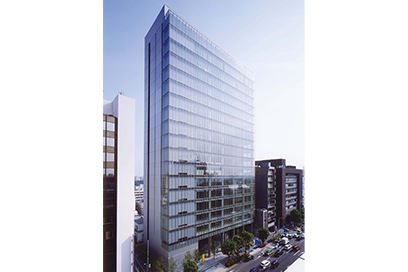
Chapter 5 Transformation
2004
2023
Section 6. Toward Our 100th Anniversary and Beyond
8. Acquiring a Partial Interest in Rakuten Crimson House Aoyama
-

Rakuten Crimson House Aoyama
In March 2024, Daibiru acquired trust beneficiary rights for a partial interest in Rakuten Crimson House Aoyama in an exchange transaction with Global One Real Estate Investment Corporation. Through this transaction, Daibiru acquired 20% trust beneficiary rights in the property, giving up a 5% co-ownership interest in the Shin-Daibiru Building land and building and a 20% co-ownership interest in the Tosabori Daibiru Building land and building in return.
Rakuten Crimson House Aoyama is located near Aoyama-Itchome Station on the Tokyo Metro. Several large-scale redevelopment projects are planned in the Aoyama area, and the value of the area is expected to increase in the future. This is a large and truly competitive office building, and by acquiring trust beneficiary rights, Daibiru aims to expand the scale of its assets in the Tokyo area. Daibiru aims to build a stronger portfolio through this transaction. Daibiru also seeks to improve medium- and long-term profitability and plans to increase actual yields through advanced depreciation of its acquired assets.
| Property overview | Rakuten Crimson House Aoyama |
|---|---|
| Address | 2-6-21 Minamiaoyama, Minato-ku, Tokyo |
| Date of completion | May 2003 |
| Construction | steel-frame construction and steel-frame reinforced concrete construction |
| Size | 17 aboveground floors, two underground floors |
| Site area | 3,039 m2 |
| Total floor area | 20,959 m2 |
-
1923 1944 Beginnings
-
Section 2. Launching a Building Management Business
-
Section 4. Business Development in Wartime
-
1945 1957 Reconstruction
-
Section 2. Our Buildings Reopen
-
1958 1988 Development
-
Section 1. Expanding the Building Management Business
- 1. The End of the Requisition of the Hibiya Daibiru Buildings
- 2. Upgrading the Facilities of the Daibiru Buildings and Damage Caused by the 2nd Muroto Typhoon
- 3. The Completion of the North Wing of the Shin-Daibiru Building
- 4. The Completion of the Yaesu Daibiru Building
- 5. The Acquisition of the Midosuji Daibiru Building
- 6. The Completion of the Kojimachi Daibiru Building
- 7. The Completion of the Uchisaiwaicho Daibiru Building
- 8. The Completion of the Dojima Daibiru Building
- 9. The Completion of the Awajimachi Daibiru Building
- 10. The Completion of the Mita-Nitto Daibiru Building
-
Section 2. Expanding the Business Through M&A
-
-
1989 2003 Expansion (1989–2003)
-
Section 1. Creating New Urban Spaces
- 1. The Bubble Economy and Daibiru
- 2. The Hibiya Daibiru Rebuilding Project
- 3. The Completion of the Rebuild
- 4. The Start and Execution of Renovation Plans
- 5. The Completion of the Kita-Umeda Daibiru Building
- 6. The Completion of the Yodoyabashi Daibiru Building
- 7. The Completion of the Estate Tosabori Building
- 8. The Completion of the Umeda Daibiru Building
- 9. The Completion of Violette Takarazuka
- 10. The Shinjuku Daibiru Building and Shiba Daibiru Building Acquisitions
-
Section 2. The Development of a New Corporate Identity and a Name Change
-
Section 3. Disaster Preparedness and Risk Management
-
-
2004 2023 Transformation (2004–2023)
-
Section 1. Becoming a Consolidated Subsidiary of Mitsui O.S.K. Lines and Promoting Management Plans
- 1. Becoming a Consolidated Subsidiary of Mitsui O.S.K. Lines
- 2. Concentrating Investment in the Tokyo Area
- 3. Expanding into Other Countries and Japanese Regions
- 4. Establishing Daibiru 3D-Project Phase I, a Medium-Term Management Plan
- 5. Establishing Our Management Philosophy and Mission Statement
- 6. Establishing Daibiru-3D Project Phase II, a New Medium-Term Management Plan
- 7. Ongoing Establishment of New Medium-Term Management Plans
-
Section 2. Expanding Our Business
- 1. The Akihabara Station Redevelopment Project and the Completion of the Akihabara Daibiru Building
- 2. The Acquisition of the Toranomon Daibiru Building
- 3. The 3 Nakanoshima Joint Development Project and the Completion of the Nakanoshima Daibiru Building
- 4. The Completion of the Tosabori Daibiru Building
- 5. The Acquisition of Aoyama Rise Square
- 6. The 3 Nakanoshima Joint Development Project and the Completion of the Daibiru-Honkan Building
- 7. Rebuilding the Shin-Daibiru Building
- 8. Renovation Work
- 9. Multiple Awards
- 10. Delving into Commercial Facilities
- 11. Acquiring a Partial Interest in the Seavans South Building
- 12. Expansion to Sapporo
- 13. Selling Seven Residential Properties
- 14. Starting the Rebuild of the Midosuji Daibiru Building
- 15. Starting the Rebuild of the Yaesu Daibiru Building
-
Section 3. Overseas Business Expansion
-
Section 4. Further Strengthening of the Corporate Structure and Group Reorganization
-
Section 5. Harmonious Coexistence with Society
- 1. Developing a Compliance System
- 2. Developing an Internal Control System
- 3. Risk Management Measures
- 4. Sustainability Initiatives
- 5. Social Contribution and Cultural Support Initiatives
- 6. Environmental Initiatives
- 7. Working Style Reform Initiatives
- 8. Launching the Brand Development Project
- 9. Launching the Head Office Renovation Project
-
Section 6. Toward Our 100th Anniversary and Beyond
- 1. Becoming a Full Subsidiary of Mitsui O.S.K. Lines
- 2. Acquiring a Partial Interest in Otemachi First Square
- 3. Acquiring a Partial Interest in the Otemon Tower / ENEOS Building
- 4. Investment in an SPC for Logistics Facilities in the Nishinomiya Area
- 5. Project Participation in the United States
- 6. Project Development in Melbourne, Australia
- 7. Formulation of a New Medium- and Long-Term Management Plan
- 8. Implementing 100th Anniversary Projects
- 9. For Future Generations
-


